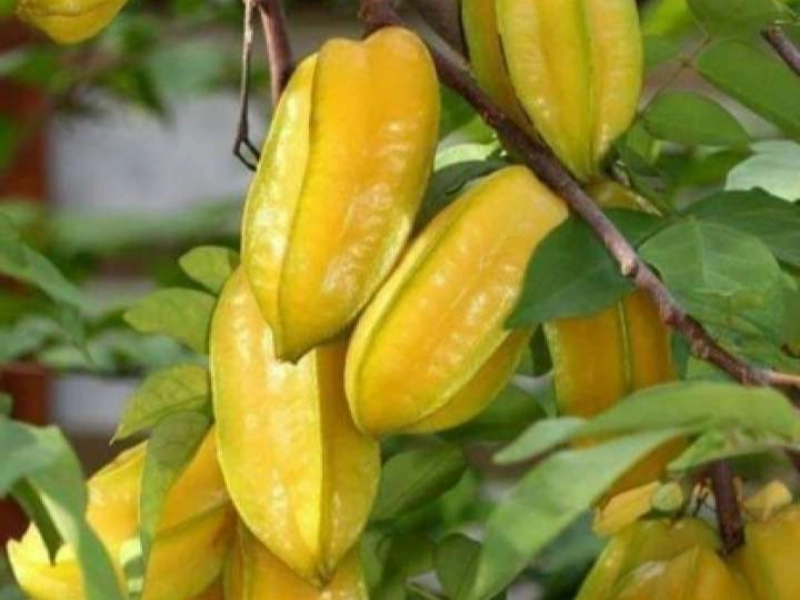Starfruit in Molecular Gastronomy
In the field of molecular gastronomy, starfruit—known for its unusual form and reviving taste—is an interesting component. This creative cooking method produces amazing dining experiences by fusing science with art. Chefs can surprise starfruit into unusual forms and textures by using methods such spherification, foaming, and gelification. This article will discuss how starfruit may be included into molecular gastronomy to improve its taste and visual appeal as well as provide a distinctive gourmet experience.
Understanding molecular gastronomy

Spherification using Starfruit
 In molecular gastronomy, spherification—making tiny, caviar-like spheres from liquids—is among the most often used methods. With starfruit juice, this method is especially successful since it lets chefs delicately shell its sweet and sour taste. Chefs blend starfruit juice with sodium alginate then put it into a calcium bath to make starfruit caviar. Small spheres resulting from this burst with taste when bitten into, offering a distinctive textural contrast to cuisine.
From garnishing cocktails to providing an unexpected aspect to desserts, these starfruit spheres find use in a variety of contexts. For a delicious tropical treat that thrills the palette, for instance, combining starfruit caviar with a coconut mousse The mix of flavors and textures not only improves the food but also offers an interactive dining experience since guests appreciate the sensation of the exploding spheres.
In molecular gastronomy, spherification—making tiny, caviar-like spheres from liquids—is among the most often used methods. With starfruit juice, this method is especially successful since it lets chefs delicately shell its sweet and sour taste. Chefs blend starfruit juice with sodium alginate then put it into a calcium bath to make starfruit caviar. Small spheres resulting from this burst with taste when bitten into, offering a distinctive textural contrast to cuisine.
From garnishing cocktails to providing an unexpected aspect to desserts, these starfruit spheres find use in a variety of contexts. For a delicious tropical treat that thrills the palette, for instance, combining starfruit caviar with a coconut mousse The mix of flavors and textures not only improves the food but also offers an interactive dining experience since guests appreciate the sensation of the exploding spheres.
Foaming Methodologies Using Starfruit
 Another amazing method in molecular gastronomy to turn starfruit into an ethereal element of a dish is foaming. Chefs can produce light, airy foams capturing the essence of starfruit by using a syphon or blender. This method lets tastes concentrate and gives a distinctive texture that could improve a dish.
For a savory meal, say grilled fish or scallops, a starfruit foam can be presented on top to provide a cool taste explosion. Blending starfruit juice with a stabilizer like lecithin will help to produce a stable and tasty foam. As the foam melts in the mouth and releases the vivid tastes of the starfruit, this method not only improves the visual attractiveness of the meal but also presents a fresh sensual experience for the diner.
Another amazing method in molecular gastronomy to turn starfruit into an ethereal element of a dish is foaming. Chefs can produce light, airy foams capturing the essence of starfruit by using a syphon or blender. This method lets tastes concentrate and gives a distinctive texture that could improve a dish.
For a savory meal, say grilled fish or scallops, a starfruit foam can be presented on top to provide a cool taste explosion. Blending starfruit juice with a stabilizer like lecithin will help to produce a stable and tasty foam. As the foam melts in the mouth and releases the vivid tastes of the starfruit, this method not only improves the visual attractiveness of the meal but also presents a fresh sensual experience for the diner.
Gelification using Starfruit
 Chefs can use gelification to turn liquids into gels, therefore producing distinctive textures and presentations. Gels made from starfruit juice can be carved into several forms and provide an artistic touch to meals. Chefs can make starfruit gels using agar-agar or gelatin that might accompany meats, shellfish, or desserts.
Imagine a plate with starfruit gel and a citrus reduction alongside grilled duck breast. Apart from offering a taste explosion, the gel creates an arresting visual contrast against the luscious duck. This mix shows how adaptable starfruit is in sweet and savory uses, therefore highlighting how molecular gastronomy can improve classic foods.
Chefs can use gelification to turn liquids into gels, therefore producing distinctive textures and presentations. Gels made from starfruit juice can be carved into several forms and provide an artistic touch to meals. Chefs can make starfruit gels using agar-agar or gelatin that might accompany meats, shellfish, or desserts.
Imagine a plate with starfruit gel and a citrus reduction alongside grilled duck breast. Apart from offering a taste explosion, the gel creates an arresting visual contrast against the luscious duck. This mix shows how adaptable starfruit is in sweet and savory uses, therefore highlighting how molecular gastronomy can improve classic foods.
Starfruit in Plateware and Presentation
Presentation is quite important in molecular gastronomy. Unique form and vivid color of starfruit make it a perfect option for imaginative plating styles. Starfruit slices are ideal decorative accents for chefs since they provide an unusual touch and a burst of color for their cuisine. The star-shaped slices can be placed in several configurations or used to give the plate height and dimension. Starfruit can also be dried to produce powders or chips, which would be used as garnishes. Dehydrated starfruit improves the whole eating experience by adding concentrated taste and a crunchy texture. Chefs can visually captivate customers by imaginatively including starfruit into the presentation of meals, therefore transforming the meal from a feast for the taste to an eye-show.
Novel Starfruit Cocktails
Beyond food, molecular gastronomy encompasses beverages, and starfruit can be rather important in creative cocktails. Bartenders can produce visually beautiful and delicious drinks by using methods such foaming and spherification. Top with a light starfruit foam, a cocktail flavored with starfruit can offer a cool and interesting beverage. For a starfruit mojito, for instance, starfruit caviar will provide taste bursts with every sip. In a same vein, a starfruit martini might have a starfruit foam to provide a creamy texture and a trace of sweetener. These creative cocktails not only highlight the adaptability of starfruit but also show how molecular gastronomy may turn conventional drinks into remarkable works of art.
Starfruit's Future in Culinary Arts
Starfruit and other exotic foods will probably find more use in fine dining as molecular gastronomy develops. Chefs are always looking for fresh approaches to surprise and please customers; starfruit provides a distinctive taste sensation and visual appeal that could improve many kinds of cuisine. Chefs may fully enjoy starfruit by experimenting with different molecular processes, therefore producing creative and unforgettable dining experiences. Including starfruit into molecular gastronomy not only emphasizes its culinary adaptability but also encourages consumers to investigate novel tastes and sensations. Starfruit is a fruit to watch in the future of gastronomy as more chefs adopt this creative approach results in even more imaginative applications of it in the culinary arts.








